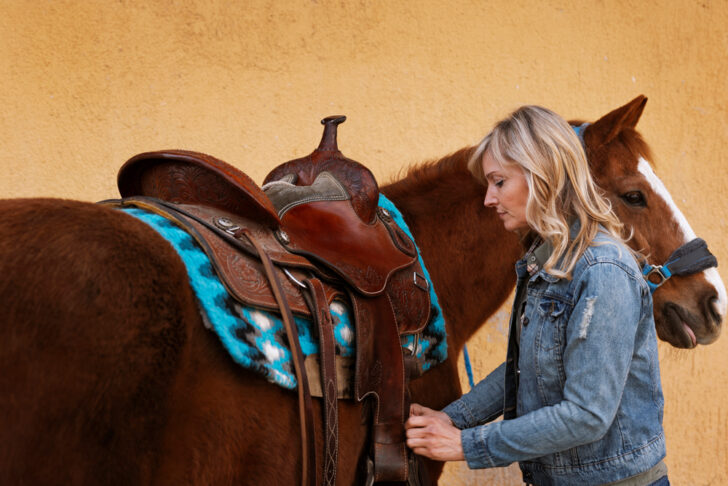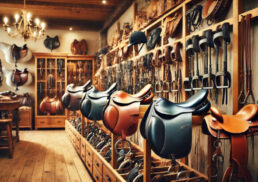
When it comes to horseback riding, the appropriate gear is crucial for both the horse and the rider.
Understanding horse tack—encompassing saddles, bridles, and bits—is essential for ensuring comfort, safety, and optimal performance.
This article examines the fundamentals of horse tack, including guidance on selecting the ideal saddle and bridle, the significance of bit selection, and proper maintenance techniques.
Regardless of whether one is an experienced rider or a novice, mastering these foundational elements will significantly enhance the riding experience.
Table of Contents
Key Takeaways:
- A well-fitting saddle, bridle, and bit are essential for both the comfort and safety of your horse and yourself as a rider.
- When choosing a saddle, consider the horse’s conformation, your riding discipline, and your own body type for the best fit.
- Proper cleaning and maintenance of horse tack is important for its longevity and effectiveness, and tack should be replaced or upgraded when necessary.
Understanding the Basics of Horse Tack
A comprehensive understanding of the fundamentals of horse tack is essential for every horse owner and rider, as it establishes the foundation for effective communication and control between the horse and rider.
Proper horse tack, including bits, bridles, and saddles, is critical to the comfort and performance of both the equine and the rider, thereby ensuring that each riding experience—be it in discipline training, dressage, jumping, or eventing—is both enjoyable and effective.
Familiarity with the various components of horse tack is crucial for tailoring the setup to meet the individual needs of the horse.
What is Horse Tack?
Horse tack encompasses the various pieces of equipment utilized in the management and riding of horses, including bits, bridles, saddles, and associated accessories.
This equipment is essential for facilitating effective communication between the rider and the horse, enabling a clear exchange of cues that guide the equine partner.
Among the fundamental components, bits play a significant role in determining the horse’s responsiveness and comfort. Options such as snaffles, curbs, and Pelhams provide varying levels of leverage and control.
Bridles, which accommodate the bit, also exhibit diverse designs that affect the horse’s comfort while ensuring that clear signals are conveyed from the rider.
By judiciously selecting the appropriate tack, riders can enhance their horse’s training experience, fostering a harmonious and effective partnership in riding and other equestrian activities.
Importance of Proper Tack for Horse and Rider
The significance of properly fitted tack for both the horse and rider cannot be overstated, as it directly influences comfort, performance, and the overall experience during equestrian activities.
When the tack is appropriately adjusted, it facilitates a better connection between the rider and the horse, allowing for clear communication and enhancing the overall riding experience. Conversely, improperly fitted equipment can result in various issues such as pain, sores, or even lasting injuries to the horse, which may adversely affect its willingness to perform.
The correct combination of bit and bridle is essential for achieving effective communication; it ensures that the rider’s cues are transmitted accurately, fostering a sense of partnership and trust.
Additionally, regular fitting sessions are crucial for maintaining optimal performance and comfort, allowing for necessary adjustments as the horse develops or undergoes changes over time.
Choosing the Right Saddle for Your Horse
Selecting the appropriate saddle for a horse is a crucial factor in ensuring both comfort and performance during riding. A poorly fitted saddle can lead to discomfort and potential injury for the equine partner.
A comprehensive understanding of the various types of saddles available, in conjunction with an awareness of the specific needs of the horse, forms the basis for a successful riding experience.
It is imperative to consider factors such as the horse’s body shape, the chosen riding discipline, and the rider’s experience level to make an informed decision regarding saddle fitting and style.
Factors to Consider When Selecting a Saddle
When selecting a saddle for a horse, it is essential to consider a variety of factors to ensure both comfort and performance. These considerations include the horse’s anatomy, the rider’s size and skill level, as well as the specific riding discipline.
The breed and build of the horse are critical in determining the appropriate fit; for example, a draft horse will require a different saddle design than a thoroughbred due to the variations in body shape and size.
Furthermore, the specific requirements of disciplines such as jumping or dressage may necessitate modifications in saddle design, including deeper seats or higher pommels, to achieve optimal balance and control.
Employing proper saddle fitting techniques, such as assessing withers clearance and ensuring appropriate gullet width, is vital to preventing discomfort or injury. Additionally, rider preferences regarding seat size, flap length, and material can significantly influence the final selection, thereby allowing for a more personalized approach to saddle choice.
Different Types of Saddles and Their Uses
Different types of saddles are specifically designed for various riding disciplines, including dressage, jumping, and eventing, each offering distinct features that enhance both performance and rider comfort.
For example, dressage saddles are characterized by a deeper seat and longer flaps, which enable riders to maintain an effective position for executing precise movements and facilitating communication with the horse. Conversely, jumping saddles are designed with a shallower seat and more forward-angled flaps to promote optimal balance and movement during jumps.
General-purpose saddles provide a high degree of versatility, making them suitable for both flatwork and jumping, and are often considered an ideal choice for beginners or riders seeking an all-around option.
Ensuring proper fit is essential across all saddle types, as it significantly impacts the horse’s movement, comfort, and overall performance, as well as the rider’s ability to maintain effective communication and balance.
Selecting the Perfect Bridle for Your Horse
Selecting the appropriate bridle for a horse is a critical component of preparing the horse for riding. The bridle serves a significant role in facilitating communication between the horse and rider, while also ensuring comfort and control during training or competitive events.
Types of Bridles and Their Functions
There are various types of bridles employed in equestrian riding, each designed with specific functions that enhance communication, control, and comfort for both the horse and the rider.
Bridles such as the Grackle, characterized by its distinctive cross-under noseband, provide a secure fit that aids in preventing the horse from evading the bit while ensuring comfort. The Mexican noseband represents another popular choice, recognized for its effectiveness in gently keeping the horse’s mouth closed, which can be particularly beneficial for more sensitive equines.
Traditional styles, often crafted from leather and featuring simple designs, offer a classic approach to bridling and typically facilitate clear communication through subtle rein aids. Each type of bridle plays a crucial role in how the bit is perceived by the horse, significantly enhancing responsiveness and ensuring that the rider’s intentions are conveyed more effectively.
How to Measure for the Right Fit
Measuring for the appropriate fit of a bridle is essential to ensure both comfort and effectiveness, as improper fitting can result in discomfort and communication challenges between the horse and rider.
A systematic approach should be adopted when assessing various aspects of the horse. The first step involves measuring the circumference of the horse’s muzzle, as this area directly impacts the fit of the noseband. Subsequently, one should evaluate the size and shape of the horse’s head, bearing in mind that different breeds often possess distinctive characteristics that influence bridle dimensions.
Regarding the browband, it is important to ensure that it sits comfortably without pinching the ears. Additionally, consider the aspect of adjustability; a bridle equipped with multiple adjustment points allows for a more tailored fit, accommodating any changes in the horse’s condition or behavior.
This ultimately contributes to enhanced performance and a stronger partnership between horse and rider.
Checkout A guide to different types of bridles both English & Western
Understanding the Role of Bits in Horse Tack
Understanding the role of bits in horse tack is essential for effective horse management. Bits serve as critical instruments for communication and control between the horse and rider, significantly influencing the overall riding experience and the performance of the horse.
Types of Bits and Their Functions
Bits are available in various types, each specifically designed to address the needs of the horse and the preferences of the rider, thereby influencing communication and overall performance.
Snaffle bits are among the most widely utilized options, recognized for their straightforward design and gentle action, which makes them particularly suitable for training and regular riding.
Conversely, curb bits offer a leverage advantage, enabling more nuanced control, which can be especially advantageous in advanced disciplines such as dressage or show jumping. The Pelham bit combines the functionalities of both snaffle and curb bits, catering to riders who seek versatility in their equipment.
Comprehending the unique characteristics and intended applications of each type is essential, as the selection of the appropriate bit can enhance the relationship between horse and rider, ensuring effective communication and optimal performance across various riding styles.
Proper Bit Selection and Fitting

Proper bit selection and fitting are critical components in ensuring an optimal riding experience, as the appropriate bit can significantly enhance both comfort and communication between the horse and rider.
Selecting the correct bit necessitates a thorough evaluation of the horse’s mouth conformation, which can vary considerably among different equines. For example, a horse with a sensitive palate may require a gentler, wider-mouthed bit, whereas a horse with a stronger jaw may benefit from a more structured design.
Additionally, it is essential to consider the horse’s experience level and specific discipline; a novice horse may respond more favorably to a snaffle that encourages natural movement, while a seasoned competitor might perform better with a different type of bit designed to refine communication.
Furthermore, proper fitting of the bit is crucial. A well-fitted bit not only prevents discomfort but also aids in maintaining the horse’s focus during rides, thereby ensuring effective communication and fostering mutual trust between the horse and rider.
Caring for Your Horse Tack
Maintaining your horse tack is crucial for ensuring its longevity and optimal performance. Regular cleaning and upkeep can prevent wear and tear, thereby safeguarding the safety of both the horse and the rider.
Proper Cleaning and Maintenance Techniques
Proper cleaning and maintenance techniques for horse tack are essential for enhancing the longevity and performance of bits, bridles, and saddles.
Regular attention not only ensures that the equipment remains in pristine condition but also guarantees its safe functionality during rides. Various materials, including leather, synthetic textiles, and metal, each necessitate distinct cleaning methods to prevent damage while effectively removing dirt and sweat.
For example, leather items benefit from conditioning after cleaning to avoid cracking, whereas synthetic materials may require merely a thorough wash with soap and water.
Routine inspections for wear and tear are crucial; identifying issues such as fraying stitching or rusting hardware can help prevent accidents during use. By implementing these practices, one fosters a safer riding experience and mitigates the risk of incurring costly replacements in the future.
Replacing and Upgrading Tack as Needed
Replacing and upgrading horse tack as necessary is crucial for maintaining optimal performance, comfort, and safety for both the horse and the rider.
Regular inspections of the equipment’s condition can significantly influence the effectiveness of this partnership during rides. Signs such as unusual wear, frayed leather, or broken buckles indicate the necessity for replacement.
As the horse develops or undergoes changes in training, its tack must adapt to these evolving needs to ensure proper fit and functionality. For example, a horse that has gained muscle mass may require different sizing to prevent discomfort or injury.
Therefore, it is advisable to schedule fitting sessions routinely, not only to assess the fit of saddles and bridles but also to make any necessary adjustments. This proactive approach can help guarantee that both the horse and rider perform at their best.









